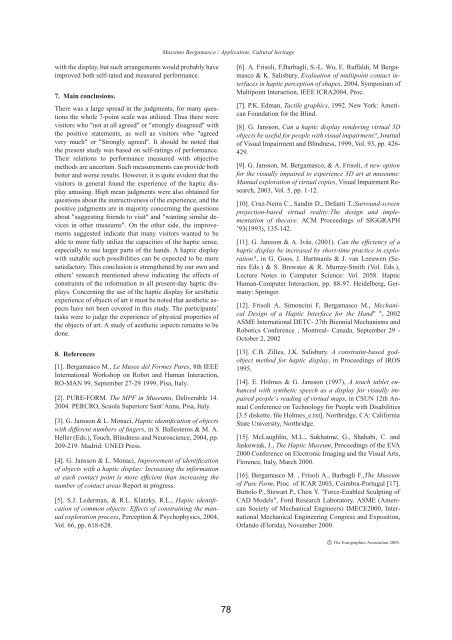full Paper - Nguyen Dang Binh
full Paper - Nguyen Dang Binh
full Paper - Nguyen Dang Binh
You also want an ePaper? Increase the reach of your titles
YUMPU automatically turns print PDFs into web optimized ePapers that Google loves.
with the display, but such arrangements would probably have<br />
improved both self-rated and measured performance.<br />
7. Main conclusions.<br />
There was a large spread in the judgments; for many questions<br />
the whole 7-point scale was utilized. Thus there were<br />
visitors who "not at all agreed" or "strongly disagreed" with<br />
the positive statements, as well as visitors who "agreed<br />
very much" or "Strongly agreed". It should be noted that<br />
the present study was based on self-ratings of performance.<br />
Their relations to performance measured with objective<br />
methods are uncertain. Such measurements can provide both<br />
better and worse results. However, it is quite evident that the<br />
visitors in general found the experience of the haptic display<br />
amusing. High mean judgments were also obtained for<br />
questions about the instructiveness of the experience, and the<br />
positive judgments are in majority concerning the questions<br />
about "suggesting friends to visit" and "wanting similar devices<br />
in other museums". On the other side, the improvements<br />
suggested indicate that many visitors wanted to be<br />
able to more <strong>full</strong>y utilize the capacities of the haptic sense,<br />
especially to use larger parts of the hands. A haptic display<br />
with suitable such possibilities can be expected to be more<br />
satisfactory. This conclusion is strengthened by our own and<br />
others’ research mentioned above indicating the effects of<br />
constraints of the information in all present-day haptic displays.<br />
Concerning the use of the haptic display for aesthetic<br />
experience of objects of art it must be noted that aesthetic aspects<br />
have not been covered in this study. The participants’<br />
tasks were to judge the experience of physical properties of<br />
the objects of art. A study of aesthetic aspects remains to be<br />
done.<br />
8. References<br />
[1]. Bergamasco M., Le Musee del Formes Pures, 8th IEEE<br />
International Workshop on Robot and Human Interaction,<br />
RO-MAN 99, September 27-29 1999, Pisa, Italy.<br />
[2]. PURE-FORM. The MPF in Museums, Deliverable 14.<br />
2004. PERCRO, Scuola Superiore Sant’Anna, Pisa, Italy.<br />
[3]. G. Jansson & L. Monaci, Haptic identification of objects<br />
with different numbers of fingers, in S. Ballesteros & M. A.<br />
Heller (Eds.), Touch, Blindness and Neuroscience, 2004, pp.<br />
209-219. Madrid: UNED Press.<br />
[4]. G. Jansson & L. Monaci, Improvement of identification<br />
of objects with a haptic display: Increasing the information<br />
at each contact point is more efficient than increasing the<br />
number of contact areas Report in progress.<br />
[5]. S.J. Lederman, & R.L. Klatzky, R.L., Haptic identification<br />
of common objects: Effects of constraining the manual<br />
exploration process, Perception & Psychophysics, 2004,<br />
Vol. 66, pp. 618-628.<br />
Massimo Bergamasco / Application, Cultural heritage<br />
78<br />
[6]. A. Frisoli, F.Barbagli, S.-L. Wu, E. Ruffaldi, M Bergamasco<br />
& K. Salisbury, Evaluation of multipoint contact interfaces<br />
in haptic perception of shapes, 2004, Symposium of<br />
Multipoint Interaction, IEEE ICRA2004, Proc.<br />
[7]. P.K. Edman, Tactile graphics, 1992. New York: American<br />
Foundation for the Blind.<br />
[8]. G. Jansson, Can a haptic display rendering virtual 3D<br />
objects be useful for people with visual impairment?, Journal<br />
of Visual Impairment and Blindness, 1999, Vol. 93, pp. 426-<br />
429.<br />
[9]. G. Jansson, M. Bergamasco, & A. Frisoli, A new option<br />
for the visually impaired to experience 3D art at museums:<br />
Manual exploration of virtual copies, Visual Impairment Research,<br />
2003, Vol. 5, pp. 1-12.<br />
[10]. Cruz-Neira C., Sandin D., Defanti T.:Surround-screen<br />
projection-based virtual reality:The design and implementation<br />
of thecave. ACM Proceedings of SIGGRAPH<br />
’93(1993), 135-142.<br />
[11]. G. Jansson & A. Ivås, (2001). Can the efficiency of a<br />
haptic display be increased by short-time practice in exploration?,<br />
in G. Goos, J. Hartmanis & J. van Leeuwen (Series<br />
Eds.) & S. Brewster & R. Murray-Smith (Vol. Eds.),<br />
Lecture Notes in Computer Science: Vol. 2058. Haptic<br />
Human-Computer Interaction, pp. 88-97. Heidelberg, Germany:<br />
Springer.<br />
[12]. Frisoli A, Simoncini F, Bergamasco M., Mechanical<br />
Design of a Haptic Interface for the Hand" ", 2002<br />
ASME International DETC- 27th Biennial Mechanisms and<br />
Robotics Conference , Montreal- Canada, September 29 -<br />
October 2, 2002<br />
[13]. C.B. Zilles, J.K. Salisbury. A constraint-based godobject<br />
method for haptic display, in Proceedings of IROS<br />
1995.<br />
[14]. E. Holmes & G. Jansson (1997), A touch tablet enhanced<br />
with synthetic speech as a display for visually impaired<br />
people’s reading of virtual maps, in CSUN 12th Annual<br />
Conference on Technology for People with Disabilities<br />
[3.5 diskette, file Holmes_e.txt]. Northridge, CA: California<br />
State University, Northridge.<br />
[15]. McLaughlin, M.L., Sukhatme, G., Shahabi, C. and<br />
Jaskowiak, J., The Haptic Museum, Proceedings of the EVA<br />
2000 Conference on Electronic Imaging and the Visual Arts,<br />
Florence, Italy, March 2000.<br />
[16]. Bergamasco M. , Frisoli A., Barbagli F.,The Museum<br />
of Pure Form, Proc. of ICAR 2003, Coimbra-Portugal [17].<br />
Buttolo P., Stewart P., Chen Y. "Force-Enabled Sculpting of<br />
CAD Models", Ford Research Laboratory, ASME (American<br />
Society of Mechanical Engineers) IMECE2000, International<br />
Mechanical Engineering Congress and Exposition,<br />
Orlando (Florida), November 2000.<br />
c The Eurographics Association 2005.
















